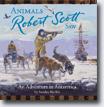 
|
Animals Robert Scott Saw is so much more than another book about Antarctic animals. This wonderful resource links natural science with history, placing both domestic and wild animals at the forefront of the story of Antarctic exploration. is so much more than another book about Antarctic animals. This wonderful resource links natural science with history, placing both domestic and wild animals at the forefront of the story of Antarctic exploration.
Concisely organized, the book is ultimately the story of Robert Scottís exploration of Antarctica with a continuing theme of animals. Beginning with a note to teachers and parents, Markle ties her subject directly into social studies and science curriculums focusing on key curricular concepts. Organized in short chapters with a complete table of contents, index, glossary, maps, phonetic spellings, and list of additional resources, the book lends itself to teaching both reading strategies and historical/scientific facts.
The age of exploration was almost over when Robert Scott began his work. Only the extreme ends of the earth (Arctic and Antarctic) were left to be explored. Beginning with a brief biography of Scott, the book chronologically explains each critical step of his voyages in brief chapters. With a focus on animals, the book covers the massive preparations including dogs to provide transportation, new discoveries of birds and their eggs, extreme conditions, penguin breeding and social patterns, etc.
Accompanying Scott as assistant surgeon, Dr. Edward Wilson documented the many animal discoveries in drawings and paintings. After returning from their first voyage, Scott found himself somewhat of a celebrity in England, and people flocked to see Wilsonís lifelike artwork.
Interest in Antarctic exploration faded for a time, and Scott was unable to obtain funding for a second voyage. However, when Ernest Shackleton, once part of Scottís crew, returned with his own expedition, public interest renewed, and Scott began his second exploratory voyage. Prepared with first-hand knowledge of the conditions, Scott included both dogs and ponies planned for the worst. The trip evolved into a race with Amundson to become the first to reach the South Pole. Although Scottís expedition came to a tragic end, the world learned much about animals and this wondrous, freezing new world from his discoveries and records.
Historic photos and postcard-like insets of important facts and sketches ground Scottís story in facts and enhance the human and animal elements of his story. Although it would be nice to see Wilsonís original paintings and drawings incorporated within the book, the historic photographs and authorís artwork are excellent.
Ending with information about current scientific investigations in Antarctica, the book is a wonderful resource for students. It is a great starter for student research, wherein students can read the book relatively quickly garnering important information, develop good questions, and move on to research additional information. Markleís focus on animals is a great hook into history for children who are naturally fascinated by animals. Other books in the series include Animals Christopher Columbus Saw, Animals Marco Polo Saw, and Animals Darwin Saw.
|







|